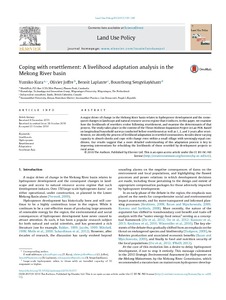Elsevier is a world-leading provider of information solutions that enhance the performance of science, health, and technology professionals.
All knowledge begins as uncommon—unrecognized, undervalued, and sometimes unaccepted. But with the right perspective, the uncommon can become the exceptional.
That’s why Elsevier is dedicated to making uncommon knowledge, common—through validation, integration, and connection. Between our carefully-curated information databases, smart social networks, intelligent search tools, and thousands of scholarly books and journals, we have a great responsibility and relentless passion for making information actionable.
Members:
Resources
Displaying 76 - 80 of 1605Assessing ecosystem services from multifunctional trees in pastures using Bayesian belief networks
A Bayesian belief network (BBN) was developed to assess preferred combinations of trees in live fences and on pastures in silvopastoral systems. The BBN was created with information from Rivas, Nicaragua, using local farmer knowledge on tree species, trees' costs and benefits, farmers' expressed needs and aspirations, and scientific knowledge regarding tree functional traits and their contribution to ecosystem services and benefits.
Coping with resettlement: A livelihood adaptation analysis in the Mekong River basin
tA major driver of change in the Mekong River basin relates to hydropower development and the conse-quent changes in landscape and natural resource access regime that it induces. In this paper, we examinehow the livelihoods of resettlers evolve following resettlement, and examine the determinants of thatprocess. The study takes place in the context of the Theun Hinboun Expansion Project in Lao PDR. Basedon longitudinal household surveys conducted before resettlement as well as 1, 2, and 3 years after reset-tlement, we identify the process of livelihood adaptation in resettled communities.
Scenarios of land system change in the Lao PDR: Transitions in response to alternative demands on goods and services provided by the land
Sudden and gradual land use changes can result in different socio-ecological systems, sometimes referred to as regime shifts. The Lao PDR (Laos) has been reported to show early signs of such regime shifts in land systems with potentially major socio-ecological implications. However, given the complex mosaic of different land systems, including shifting cultivation, such changes are not easily assessed using traditional land cover data. Moreover, regime shifts in land systems are difficult to simulate with traditional land cover modelling approaches.
Spatio-temporal analysis and simulation pattern of land use/cover changes, case study: Naghadeh, Iran
As a result of the growing impacts on global environments, it has become important for land use planners to extract, detect, monitor and predict land use/cover changes (LUCCs). The monitoring of LUCCs within a certain time period and predicting future trends of temporal and spatial changes are absolutely necessary. The aim of this research was to analyze and monitor LUCCs in Naghadeh County, Iran over a time span of 27 years and predict the future trend of changes during the period of 2014–2041.
Should big cities grow? Scenario-based cellular automata urban growth modeling and policy applications
The formation of ‘Urban Networks’ has become a wide-spread phenomenon around the world. In the study of metropolitan regions, there are competing or diverging views about management and control of environmental and land-use factors as well as about scales and arrangements of settlements. Especially in China, these matters alongside of regulatory aspects, infrastructure applications, and resource allocations, are important because of population concentrations and the overlapping of urban areas with other land resources.





